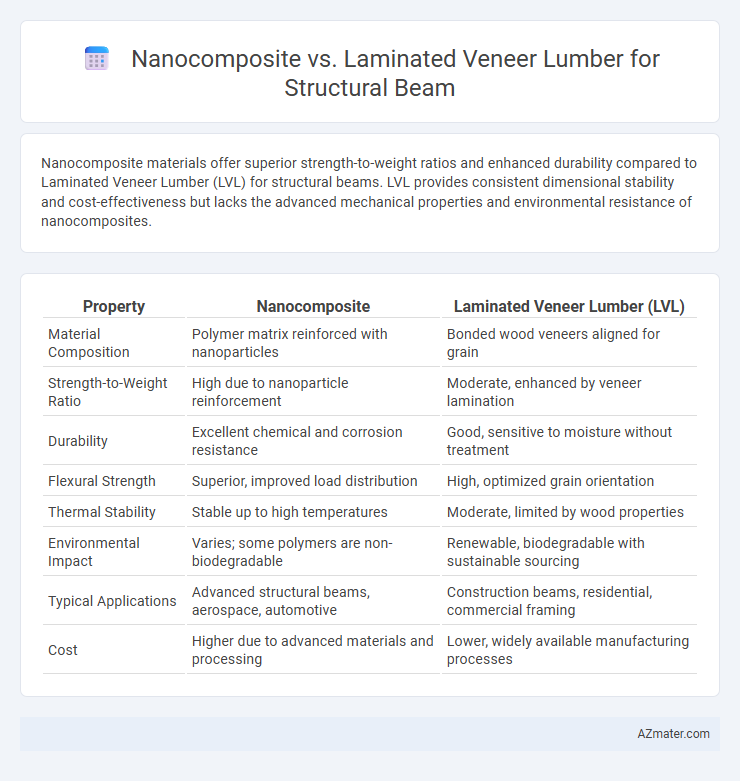Nanocomposite materials offer superior strength-to-weight ratios and enhanced durability compared to Laminated Veneer Lumber (LVL) for structural beams. LVL provides consistent dimensional stability and cost-effectiveness but lacks the advanced mechanical properties and environmental resistance of nanocomposites.
Table of Comparison
| Property | Nanocomposite | Laminated Veneer Lumber (LVL) |
|---|---|---|
| Material Composition | Polymer matrix reinforced with nanoparticles | Bonded wood veneers aligned for grain |
| Strength-to-Weight Ratio | High due to nanoparticle reinforcement | Moderate, enhanced by veneer lamination |
| Durability | Excellent chemical and corrosion resistance | Good, sensitive to moisture without treatment |
| Flexural Strength | Superior, improved load distribution | High, optimized grain orientation |
| Thermal Stability | Stable up to high temperatures | Moderate, limited by wood properties |
| Environmental Impact | Varies; some polymers are non-biodegradable | Renewable, biodegradable with sustainable sourcing |
| Typical Applications | Advanced structural beams, aerospace, automotive | Construction beams, residential, commercial framing |
| Cost | Higher due to advanced materials and processing | Lower, widely available manufacturing processes |
Introduction to Modern Structural Beams
Nanocomposites and laminated veneer lumber (LVL) represent advanced materials in modern structural beams, offering enhanced mechanical properties and durability. Nanocomposites incorporate nanoscale fillers, improving strength-to-weight ratio, stiffness, and resistance to environmental degradation compared to traditional wood products. LVL, composed of multiple layers of bonded wood veneers, provides consistent performance, high load-bearing capacity, and dimensional stability, making both materials critical in innovative construction applications.
Overview of Nanocomposite Materials
Nanocomposite materials consist of a polymer matrix embedded with nanoscale fillers such as carbon nanotubes, nanoclays, or graphene, enhancing mechanical properties like strength, stiffness, and durability compared to traditional composites. These materials offer superior load-bearing capacity and improved resistance to environmental degradation, making them suitable for advanced structural applications. Nanocomposite beams provide increased performance efficiency and reduced weight, outperforming laminated veneer lumber (LVL) in terms of structural strength and longevity.
What is Laminated Veneer Lumber (LVL)?
Laminated Veneer Lumber (LVL) is an engineered wood product made by bonding thin wood veneers together under heat and pressure, forming strong, uniform structural beams. LVL offers high strength-to-weight ratios, consistent performance, and excellent stability, making it ideal for load-bearing applications such as beams, headers, and joists. Compared to nanocomposites, LVL provides reliable mechanical properties with established industry standards and widespread availability in construction projects.
Mechanical Properties Comparison
Nanocomposite materials exhibit superior mechanical properties compared to laminated veneer lumber (LVL), including higher tensile strength, improved stiffness, and enhanced impact resistance due to the uniform dispersion of nanoparticles within the polymer matrix. LVL offers consistent dimensional stability and load-bearing capacity through its layered wood veneers bonded with adhesive, but generally falls short in strength-to-weight ratio when compared to nanocomposites. The integration of nanomaterials within composite matrices significantly increases mechanical performance, making nanocomposite beams more suitable for high-stress structural applications where durability and resilience are critical.
Durability and Lifespan Analysis
Nanocomposite beams exhibit enhanced durability due to their improved resistance to moisture, insects, and environmental degradation compared to traditional laminated veneer lumber (LVL). The incorporation of nanoparticles in nanocomposites leads to a prolonged lifespan by minimizing micro-cracks and structural fatigue commonly seen in LVL under cyclic loading conditions. Studies indicate nanocomposite structural beams can extend service life by up to 30% versus LVL, providing superior long-term performance in load-bearing applications.
Weight and Density Considerations
Nanocomposite materials exhibit significantly lower weight and density compared to Laminated Veneer Lumber (LVL), offering enhanced strength-to-weight ratios critical for structural beam applications. LVL typically has a density ranging from 600 to 700 kg/m3, whereas nanocomposites can be engineered to densities as low as 200 to 400 kg/m3, optimizing load-bearing capacity while minimizing dead load on structures. Weight reductions achieved through nanocomposites improve handling and installation efficiency without compromising the mechanical performance required for structural beams.
Cost Efficiency and Economic Impact
Nanocomposite beams offer superior cost efficiency compared to Laminated Veneer Lumber (LVL) due to their enhanced durability and lower maintenance requirements, reducing long-term expenses in structural applications. Manufacturing processes for nanocomposites leverage advanced materials like carbon nanotubes or nanoclays, which increase performance while optimizing raw material usage, resulting in favorable life-cycle cost benefits. LVL remains a competitive choice for budget-sensitive projects given its established supply chain and lower upfront costs, but nanocomposites provide greater economic impact through improved strength-to-weight ratios and extended service life, minimizing replacement and repair costs.
Sustainability and Environmental Impact
Nanocomposites offer enhanced sustainability in structural beams by utilizing nanoscale reinforcement materials that improve strength and reduce overall material consumption, leading to lower carbon emissions during production. Laminated Veneer Lumber (LVL), made from thin wood veneers bonded with adhesives, promotes efficient forest resource use and reduces waste through engineered layering but may involve formaldehyde-based resins that raise environmental concerns. Comparing both, nanocomposites exhibit potential for significant environmental impact reduction due to material efficiency and recyclability, while LVL supports renewable resource utilization but requires careful management of adhesive emissions and end-of-life disposal.
Application Scenarios and Performance
Nanocomposites exhibit superior strength-to-weight ratios and enhanced durability, making them ideal for high-performance structural beams in aerospace and automotive applications where weight reduction is critical. Laminated Veneer Lumber (LVL) offers excellent dimensional stability and uniformity, favored in residential and commercial construction for long-span floor joists, rafters, and beams due to its cost-effectiveness and ease of fabrication. The choice between nanocomposite and LVL beams depends on specific performance requirements, environmental exposure, and load-bearing demands in targeted application scenarios.
Future Trends in Structural Beam Technology
Nanocomposite materials are advancing structural beam technology by enhancing strength-to-weight ratios and improving durability through nanoscale reinforcement, outperforming traditional Laminated Veneer Lumber (LVL) in resistance to environmental degradation. Future trends indicate a shift towards hybrid beams combining nanocomposites with LVL to optimize mechanical performance and sustainability. Integration of smart sensors within nanocomposite-based beams promises real-time monitoring for structural health, revolutionizing maintenance and lifecycle management in construction.

Infographic: Nanocomposite vs Laminated Veneer Lumber for Structural Beam
 azmater.com
azmater.com